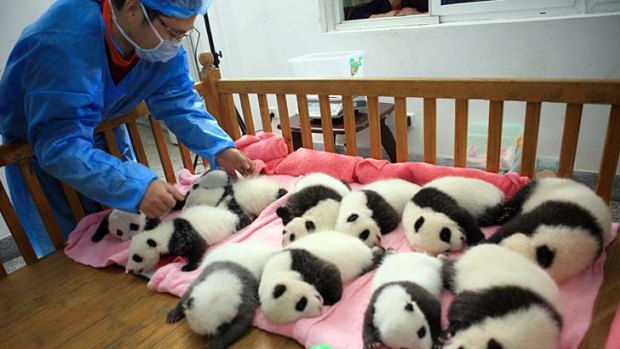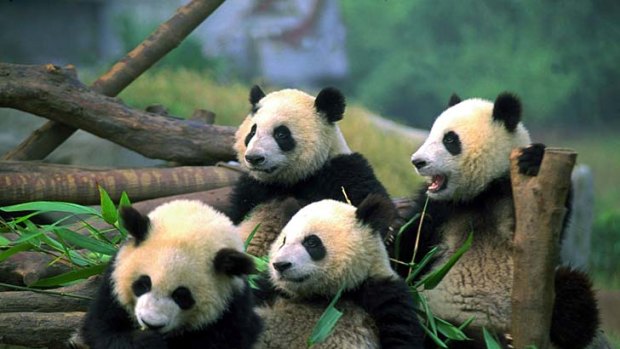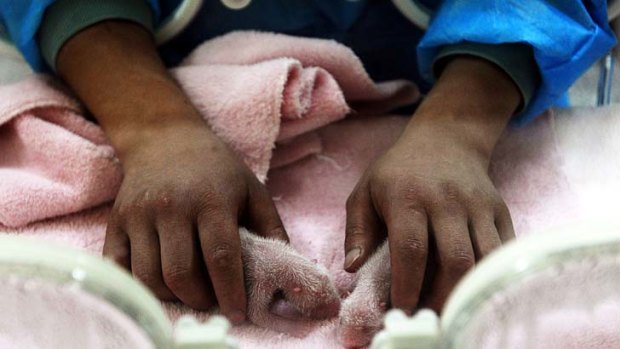
Panda cubs nap in the nursery.Credit: AFP
Stephen Phelan is thrilled to see a panda up close. But for the star of the show, it's a giant yawn.
We came only for the pandas. Thirty-six hours non-stop on a train from Shanghai, across the interior of China, almost to the border of Tibet, on "hard sleeper" beds in smoky, crowded compartments.
There is no question of the trip being worth it because pandas are at the end of it. Hundreds of them. Or at least 108, according to the last count at the Chengdu Panda Breeding and Research Centre in Sichuan Province, including 12 cubs born here during the past summer.

Older pandas frolic in an enclosure.Credit: AFP
There are other reasons to visit Sichuan: the superbly spicy food, the mountains and plains, the fact Chengdu is one of the greenest and most pleasant cities in China.
There are other places to look for pandas in Sichuan, where more than 80 per cent of the estimated 1596 remaining members of the species live in its nature reserves. (The last national survey of pandas was in 2003 and most experts are confident the panda population has grown since then.)
The Chengdu centre, sometimes simply known as the Panda Base, is the only location on Earth where so many can be seen at once, up close. This prospect has been drawing travellers thousands of kilometres out of their way since the facility opened to the public in 1993.

Sleep time ... newborn panda cubs at the Panda Base in Chengdu.Credit: AFP
We arrive in the early-morning mist at the same time as dozens of others; everyone is in rented jeeps and minivans, and accompanied by drivers and guides who have told us the same thing: the pandas are liveliest before breakfast.
Even so, we are greeted with a yawn. The first giant panda we have ever encountered outside a zoo is lying flat on his back inside a very zoo-like enclosure, his legs splayed to expose the lie that these creatures are painfully modest.
It is probably asking too much of any one panda to be a dignified ambassador for his species and perhaps it's unfair to expect this base to be something wilder and less manicured than a tourist attraction. Admission fees and visitor donations fund the research and breeding programs that go on behind the scenes here.
In return, the animals are presented in a crowd-pleasing arrangement, dispersed into small groups of mature males and females, cubs and "sub-adults" across 37 hectares of parkland inlaid with ponds, avenues and gift shops.
A few other vulnerable species are also in residence, including South China tigers, golden monkeys and the fun-sized red pandas, which prove almost as popular as their bigger bearish cousins because they are that much friskier.
But if all the children wearing giant panda-head hats are disappointed to find the real things sleeping or sitting half-hidden in thickets of bamboo, then it doesn't show.
They gather around the enclosures like adults around a baby's crib, where every little twitch provokes a disproportionate gasp of delight.
We grown-ups find it no less difficult to suppress our own involuntary squeals, especially at the glass wall of the in-house incubator, behind which a two-week-old cub is burrowing under his blanket so we can see only his still-pink mousy tail and tiny kicking feet.
Through her blue surgical face mask, breeder Mei Yan tells us the newborn - the first of several due to different mothers in the following weeks - has not been named yet, so I secretly christen him Guinness, in honour of his colour-to-be. (The naming of pandas can be a diplomatic issue. China offered a set of twins to a zoo in Taiwan with the politically charged names Tuan Tuan and Yuan Yuan, which taken together mean "reunification".)
Young Guinness is one of 161 cubs to be born at this base since it began operations with only six pandas almost 25 years ago. Most of them have survived to maturity, with a single fertile female called Mei Mei producing more than 30 healthy cubs in four generations of offspring.
Some have since been lent to foreign wildlife parks; others stayed here to have babies of their own. In the film screening at the on-site Panda Story Cinema, this process is described as two pandas "falling in love", a euphemism that doesn't hint at the uncomfortable science and technology of artificial insemination, the cryo-preservation of embryos and the harvesting of sperm from male pandas using a device that looks like an electric cattle prod.
The giant panda might already be extinct without such drastic interference by humans. The flip side is they would not be so endangered if not for humans. Among many things we learn in the on-site museum is that pandas used to be wide-roaming, meat-eating bears from China's snowier regions (which accounts for their black-and-white camouflage), whose territory shrank to forests where bamboo was the only abundant food source. Bamboo provides so little nutrition that pandas need to consume a lot of it. They slowly lost the energy to fight, or to mate. Then we began to cut down their trees.
The largely passive animal we find so cute has come a long, sad way from the ferocious carnivore Emperor Huang supposedly sent into battle 4000 years ago; a painted mural on the museum wall shows a giant panda getting stuck into the forces of his rival, Emperor Yan.
Certain conservationists have suggested the effort to save this species is expensive, impractical and purely sentimental. They argue there is no point in breeding captive pandas at Chengdu when too little is left of their natural habitat for large numbers to survive in the wild.
But the argument against this program is almost impossible to accept while looking at the living results. One particular "sub-adult" provides the most inadvertent entertainment: first comedy, by climbing awkwardly up a tall tree inside his enclosure, then suspense when he cannot get down again. His human audience holds its collective breath while he dangles from a branch. We all shout "Oh no!" in different languages when he falls into a bush.
And we cheer when he shuffles out, unharmed and apparently unembarrassed.
It is easier, at such close proximity, to understand the urge to climb the fence and cuddle one of these creatures. Several Chinese have attempted it in recent years and a few of them picked the wrong panda: a male named Gu Gu at Beijing Zoo is now famous for mauling no fewer than three fans whose affection got the better of their judgment.
For a fee of 1000 yuan ($160), it's possible to cuddle a smaller and more manageable specimen at Chengdu. It's tempting for those who can afford it but it's better to remember that even baby pandas were not built for hugging.
At the Panda Base, you learn to see these animals for the first time.
Their faces are only so round and endearing because of the powerful jaws underneath, which were once used for rending flesh. The pandas might not have forgotten this and sometimes they remind us.
And, funny as they can be, they also make you want to cry. In evolutionary terms, the giant panda's time has long since passed. But, sentimental creatures that we are, we want to hold them and not let them go.
FAST FACTS
Getting there
China Southern Airlines has a fare to Chengdu from Sydney and Melbourne for about $700 low-season return, including tax. Fly to Guangzhou (about 10hr), then to Chengdu (2hr 20min); see flychinasouthern.com. Australians require a visa for a stay of up to 30 days.
The Chengdu Panda Breeding and Research Centre is about 10 kilometres from the city. Bus 902 goes directly to the centre from Xinnanmen Station, but most hotels and guesthouses can arrange day trips and group tours, which include transport and centre entry fee of 58 yuan ($9.30).
Staying there
Sam's Guesthouse is a well-preserved historical inn tucked behind the modern city centre, with a hidden garden and traditional teahouse set inside an old stone courtyard. At 130 Shanxijie Street, rooms cost from 133 yuan; see hostelchengdu.com.
More information
Sign up for the Traveller Deals newsletter
Get exclusive travel deals delivered straight to your inbox. Sign up now.